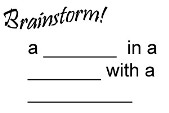|
Here are three beginnings from famous short stories. In one paragraph, these
authors set the scene with details of weather, time of day, and location.
They introduce the major characters and show the overall mood of the story through word choice.
The words highlighted in purple below are examples of good details and word choice.
The Lottery | Shirley Jackson
The morning of June 27th was clear
and sunny, with the fresh warmth of a full-summer day; the flowers
were blossoming profusely and the grass was richly
green. The people of the village began to gather in the square, between
the post office and the bank, around ten o`clock; in some towns there were so many people
that the lottery took two days and had to be started on June 26th, but in this village, where there were only about
three hundred people, the whole lottery took less than two hours, so it could begin at ten o`clock in the morning and still
be through in time to allow the villagers to get home for noon dinner.
The Vendetta | Guy de Maupassant
Paolo
Saverini’s widow lived alone with her son in a poor little house on the ramparts of
Bonifacio. The town, built on a spur of the mountains, in places actually overhanging the sea,
looks across a channel bristling with reefs, to the lower shores of Sardinia. At its foot, on the other side
and almost completely surrounding it, is the channel that serves as its harbour, cut in the cliff like a gigantic corridor.
Through a long circuit between steep walls, the channel brings to the very foot of the first houses the little Italian or
Sardinian fishing-boats, and, every fortnight, the old steamboat that runs to and from Ajaccio.
To Build a Fire | Jack London
Day had broken cold and grey, exceedingly cold and grey, when the man turned aside from the main Yukon trail and climbed the high earth-bank,
where a dim and little-travelled trail led eastward through the fat spruce timberland. It was a steep bank, and he paused for breath at the top, excusing the act to
himself by looking at his watch. It was nine o'clock. There was no sun
nor hint of sun, though there was not a cloud in the sky. It was a clear day, and yet there seemed an intangible pall over
the face of things, a subtle gloom that made the day dark, and that was due to the absence of sun. This fact did not worry
the man. He was used to the lack of sun. It had been days since he had seen the sun, and he knew that a few more days must
pass before that cheerful orb, due south, would just peep above the sky-line and dip immediately from view.
Within a few sentences, these authors have created a world. The reader can tell
who is in the story, what is happening, when it is happening and where.
The Lottery
Who? About three hundred villagers.
What? They are gathering for a lottery.
When? June 27th at 10am, probably in the 1900's or later (there is a bank and a post office).
Where? In the town square.
The Vendetta
Who? A widow and her son.
What? They are living alone in a poor little house.
When? In the late 1800's or early 1900's (the reader can guess this from the detail of the steamboat).
Where? On the cliffs of the town of Bonifacio, in France.
To Build a Fire
Who? A man.
What? He is traveling on foot through a forested area, and has just turned aside from the main trail.
When? 9am, in the 1900's or modern times (he is wearing a watch).
Where? A path off the main Yukon trail; the Yukon is a Canadian territory near Alaska.

Now, it's your turn. Write the first paragraph of a short story. Make
sure that it is no shorter than two sentences, but no longer than eight sentences. Try to answer the questions Who,
What, When and Where by showing details, as these authors did.
For example, in The Lottery, instead of just stating, "It was ten in the morning
on June 27th. The villagers came to the town square to have a lottery," Shirley Jackson gives the reader details of
flowers blossoming, rich green grass, three hundred people gathering in the square between the post office and the bank, and
so on. She uses specific details of colors, weather, and the number of people to build up a picture of what is
happening in the reader's mind.
|

